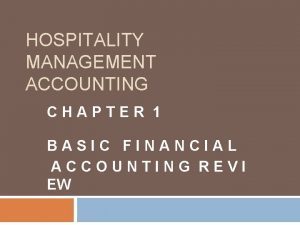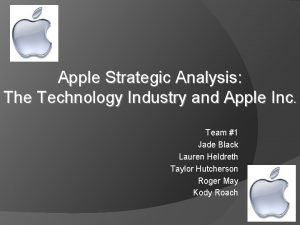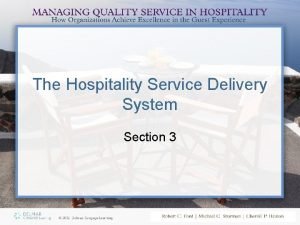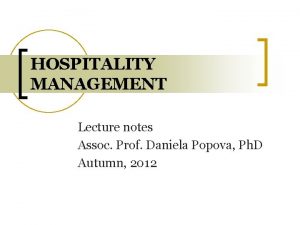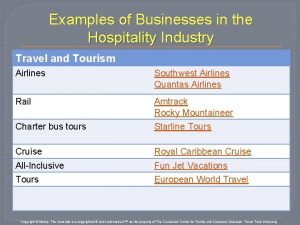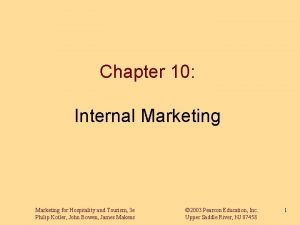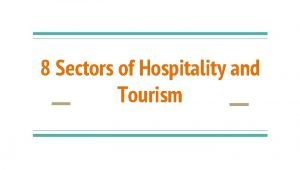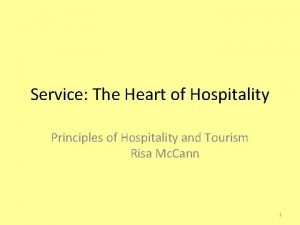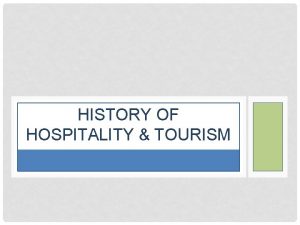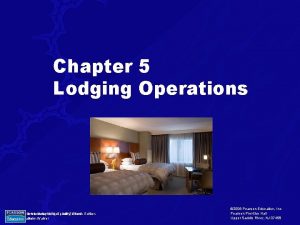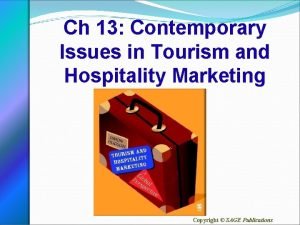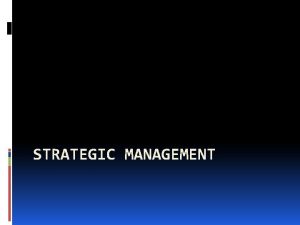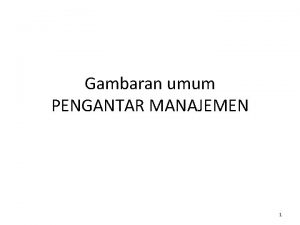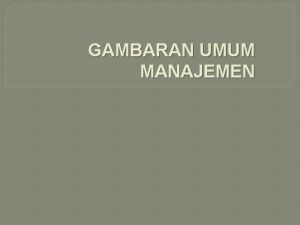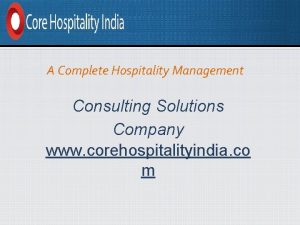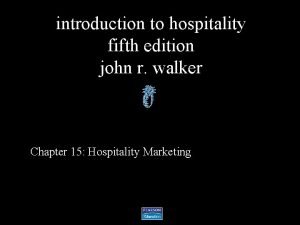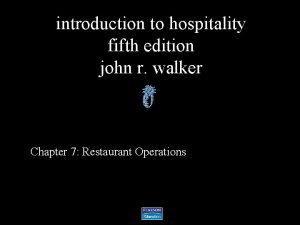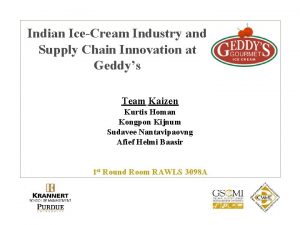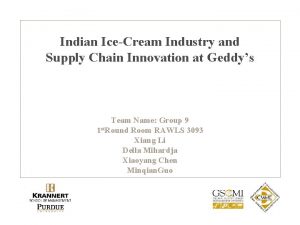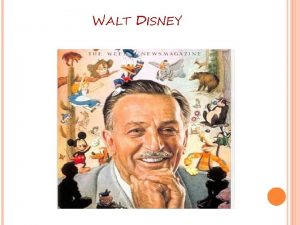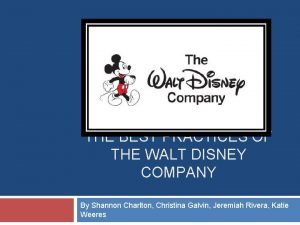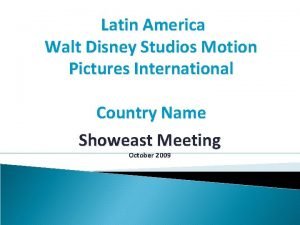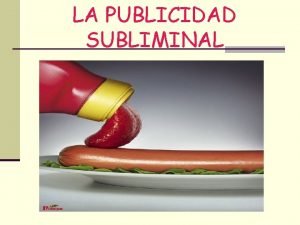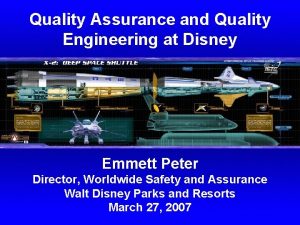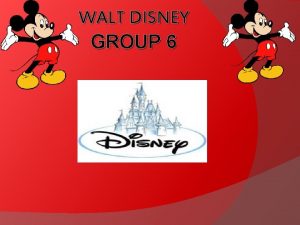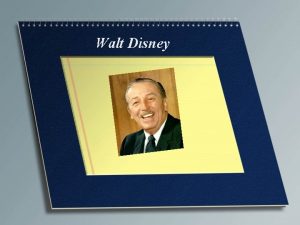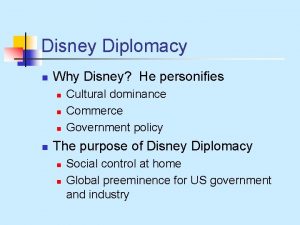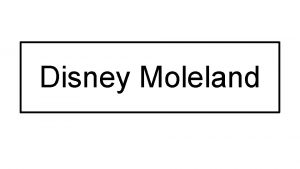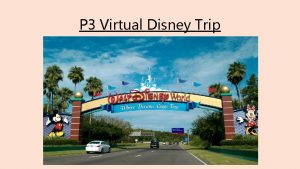HOSPITALITY MANAGEMENT 1 Hospitality Industry overview 2 Disney



























































































- Slides: 91

HOSPITALITY MANAGEMENT 1. Hospitality Industry overview 2. Disney SERVICE success model) 3. Clasification of Hotels 4. Types of rooms 5. Structure of a hotel by Departments

HOSPITALITY MANAGEMENT

HOSPITALITY MANAGEMENT

HOSPITALITY MANAGEMENT

Defining the hospitality

Defining the hospitality KINDNESS, CATER NEEDS, RECEIVING, ENTERTAINING - the act of kindness in welcoming and looking after the basic needs of guests or strangers, mainly in relation to food, drink and accommodation; - refers to the relationship process between a guest and a host; - the reception and entertainment of guests, visitors, or strangers with liberality and goodwill (Oxford English Dictionary); - derived from the Latin word hospitare meaning to “receive as a guest”

Defining the hospitality SERVICE INDUSTRY / SECTOR The hospitality field, by definition, is a service industry. Its task is to create shareholder wealth by servicing and satisfying guests. Industry segments include, among others: hotels, restaurants, private clubs, managed food service, event planning, tourism related businesses, and travel providers. More often than not, the product purchased is either intangible or the perceived quality of the product purchased is impacted by the service method in which it was received.

Defining the hospitality

Defining the hospitality VALUE & RESPECT Langhorn (2004) noted that in hospitality, the service provider is “part of the product itself”. For guests to be satisfied, they not only must believe that they have received a valuable service for their dollar, but also feel valued and respected by the workers providing the service (Kernbach & Schutte, 2005; Langhorn, 2004; Varca, 2004; Winsted, 2000). Sheila A. Scott-Halsell, Shane C. Blum & Lynn Huffman (2008): A Study of Emotional Intelligence Levels in Hospitality Industry Professionals, Journal of Human Resources in Hospitality & Tourism, Vol. 7(2), 135 -152

The objectives of hospitality industry 1. Making the guests feel welcome personally 2. Making things work for the guests 3. Making sure that the operation will continue to provide service and meet its budget

TRENDS influencing the hospitality industry • Social impact • Technology; • More leisure time • More comfortable travel; • Short, last minute trips • Communication; • Seasonality not a factor • Aging population; • Greater disposable • Early retirement income • Longer life span • Political changes • Two wage earner families • Smaller families • Change in consumer spending patterns

IDEAS for HOTELS in Iași How should they respond to these trends? • Social impact • Technology; • More leisure time • More comfortable travel; • Short, last minute trips • Communication; • Seasonality not a factor • Aging population; • Greater disposable • Early retirement income • Longer life span • Political changes • Two wage earner families • Smaller families • Change in consumer spending patterns

IDEAS for HOTELS in Iași How should they respond to these trends? • Social impact • Technology; • More leisure time • More comfortable travel; • Short, last minute trips • Communication; • Seasonality not a factor • Aging population; • Greater disposable • Early retirement income • Longer life span • Political changes • Two wage earner families • Smaller families • Change in consumer spending patterns

IDEAS for HOTELS in Iași How should they respond to these trends? • Social impact • Technology; • More leisure time • More comfortable travel; • Short, last minute trips • Communication; • Seasonality not a factor • Aging population; • Greater disposable • Early retirement income • Longer life span • Political changes • Two wage earner families • Smaller families • Change in consumer spending patterns

OTHER TRENDS in the Hospitality Industry n Demand for leisure travel n Activities that promote stress reduction will gain in popularity n Expect to be "fired" if you’re not wired n Meetings and conventions will drive the recovery of demand for business travel services n Air travel will remain remarkably affordable

Trends Affecting the Future of the Hospitality Industry - Increasing competition; - Emphasis on service; - Customers’ growing value consciousness; - Changes in marketing and management made possible by technology;

Trends Affecting the Future of the Hospitality Industry - Increased responsibility for employees and managers through employment; - Greater diversity of the workforce; - Customers’ concerns with security - Consumers’ and governments’ concern with sanitation - Globalization

The success of the service - Focus on the guest - Understand the role of the guest-contact employee - Weave a service culture into education and training systems - Thrive on change

Disney SERVICE Model Keywords in providing an excellent service

STANDARDS of SERVICE n Since the creation of first Disneyland in 1955, in California, the company has established a series of CUSTOMER SERVICE standards n S. E. R. V. I. C. E. model 4 KEYS to a great Customer Experience 7 Deadly sins of service L. A. S. T. model n n n

What is CUSTOMER SERVICE?

What is CUSTOMER SERVICE? n A series of activities designed to enhance the level of customer satisfaction which give him/her the feeling that the product (goods & services) has met his/her expectations.

What is CUSTOMER SERVICE? n n n Companies use marketing and service tactics to draw customers in and make them want more. Some of the most successful companies have recently realized that quality customer service is ultimately what makes or breaks their business. The availability of a product is not the only part of a transaction that a customer takes into consideration anymore (Wilder, Collier & Barnes, 2014).

S. E. R. V. I. C. E. model Smile Eye contact Respect and welcome all guests Value the magic Initiate guest contact Creative service solutions End with a “thank you”

4 Keys to Customer Experience n n Safety - Siguranța Courtesy – Politețea Show – Spectacolul / Rolul Efficiency – Eficiența

4 Keys to Customer Experience Safety n I practice safe behaviors in everything I do n I take action to always put safety first. n I speak up to ensure the safety of Others Courtesy n I project a positive image and energy n I am courteous and respectful to Guests of all ages n I go above and beyond to exceed Guest expectations Show n I stay in character and perform my role in the show n I ensure my area is show-ready at all times Efficiency n I perform my role efficiently so Guests get the most out of their visit n I use my time and resources wisely

7 Deadly sins of service (by Schmidt) - Apathy (absence of passion) - Brush-off (To ignore or behave coldly toward); - Coldness - Condescension (lack of respect) - Robotics - Rule book - Runaround (form of evasive excuses )

7 Deadly sins of service (by Schmidt) n 1. Apathy / Apatia Customers’ questions and issues are important to them, and they expect that those questions and issues will be important to the people they do business with. When employees don’t seem to care — perhaps because they’re preoccupied or express no emotion in their tone — customers will be upset. n 2. The Brush-off / Indiferența This often comes in the form of phone trees, where customers can’t dial through to a person. In other situations, it’s when one front-line rep passes a customer onto someone else for help. The person who hears customers first should almost always make sure they’re happy to the end. n 3. Coldness / Detașarea This is apathy and the brush-off combined and at their worst. In this situation, an employee might fail to acknowledge that a customer has brought up a legitimate problem or might address it as if it’s a nuisance. Frontliners need to stay warm and focused on one person at a time. n 4. Condescension / Aroganța When employees use jargon, acronyms or language that doesn’t sound like what customers use, they’re condescending. Front-line employees want to mimic customers’ language and rate of speech, and avoid company and industry jargon.

7 Deadly sins of service (by Schmidt) n 5. Robotism / Robotismul This is often displayed in a customer service pro who starts interactions by asking for account numbers, phone numbers or other generic information, rather than trying to make conversation. Employees want to ask at least one personalized question before going to task. n 6. Rule books / Regulile fixe When employees just follow the rules, rather than common sense or their hearts, they come across as cold and uncaring. That might be OK for routine transactions, but complex, emotional and special situations always call for thoughtfulness. n 7. Runaround / Angajatul mereu ocupat Employees might give customers the runaround when they continually suggest customers look at a website, fill out paperwork or make another call. Many times, employees need to walk them through what they need to do. Eventually, customers will be able to figure it out for themselves.

L. A. S. T. model n https: //www. youtube. com/watch? v=dn p. Mq. Qnt 8 WY

The accommodation

Classification of hotels Criteria: - Location: e. g. city centre hotels, suburban hotels, airport hotels and highway hotels/motels - Function: e. g. commercial hotels and convention hotels - Market segment: e. g. resorts, health spas, timeshares/vacation ownership and casino hotels - Distinctiveness of property: e. g. all-suite hotels, boutique hotels, extended-stay hotels, historic conversions and bed and breakfast inns - Price and staff/room ratio - Size: e. g. under 150 rooms, 151 -300 rooms, 301 -600 rooms, more than 600 rooms - Rating (grading) : e. g. one-star to five-star or one-diamond to five-diamond

What Makes a 4 -star Hotel? n ? ?

What Makes a 4 -star Hotel? n n n size of rooms (18 mp) and amenities (stationary, armchairs, table, safe in room), room height (2. 8 m) bathroom size (4 mp) and amenities (dryer, robe, slippers) size of reception area (2 mp / room) languages spoken by staff (50%) food available parking (40% no rooms) baggage / porter Fast elevators own power Room service, breakfast FACILITIES: Bar, Conference halls, Relaxation

Ownership types: - Private: An independent hotel owned by a person/partnership/private company; - Local group: Several hotels owned by a local company - International group: A hotel which is part of an international chain of hotels Any functional differences?

Types of hotels ?

Types of hotels (I) n n n n n - City centre hotels - Suburban hotels - Airport hotels - Highway hotels/Motels - Convention hotels - Commercial hotels - Resort hotels - Spa hotels - Historic conversion hotels - Bed and breakfast inns (B&Bs)

Types of hotels (II) n n n n n - Timeshares/Vacation ownership - Casino hotels - All-suite hotels - Boutique hotels - Extended stay hotels/Serviced Apartments - Guest houses - Hostels - Cabins - Villas/Chalets (usually in skiing and beach resorts)

Which differences? n n n n n - City centre hotels - Suburban hotels - Airport hotels - Highway hotels/Motels - Convention hotels - Commercial hotels - Resort hotels - Spa hotels - Historic conversion hotels - Bed and breakfast inns (B&Bs)

Hotel management Hotels can be operated in one of the following ways: - Independently owned and operated These can be independent hotels, with no affiliation, that are being managed by the -owners of the properties. - Management contracts are hotel management companies which operate properties owned by other entities. In some cases, the hotel owners may arrange to run their properties through a management contract with a company that specialises in managing hotels.

Hotel management Why MANAGEMENT CONTRACT? The reason for this is that the owner may not: - Have the necessary expertise; - Desire to become involved in the operation of the hotel; Benefits for the hotel management company: - Little or no up-front financing or equity involved - Manage the property for the contract period such as five, ten or twenty years - Receive a management fee during the contract period

Hotel management - Franchising Some investors prefer to use the franchising concept in running the hotel. Franchising in the hospitality industry is a concept that: - Allows interested investors to use a company’s (the franchisor) name and business format -- Is made up of properties where the franchisees agree to run the hotel in accordance with the strict guidelines set by the franchisor - Allows a company to expand more rapidly by using others’ capital

Hotel management Benefits for the franchisee: - Obtain from the franchisor the expertise in doing business such as site selection, planning, pre-opening training, operations manuals, information management, central reservation system, field support, quality control, purchasing, advertising, marketing, new products and concepts - The franchisee has complete control and responsibility over the daily operation of the property In return, the franchisor receives a joining fee and an ongoing fee from the franchisee.

Hotel management - Referrals Referral associations, e. g. Leading Hotels of the World (LHW), offer to hotels similar benefits as franchising, but at a lower cost. Some hotels choose to become a referral property. This means that the property is being operated as an independent hotel in association with a certain chain. These hotels refer guests to one another’s properties and share a centralised reservation system, a common logo, image, or advertising slogan. Hotels pay an initial fee to join a referral association and further fees are based on services required.

Hotel management Referrals As the property has already been physically developed, the owner may want assistance only with marketing, advertising, management, or reservation referral. In addition, guests may find more variation among the referral properties as size and appearance standards are less stringent than those in a franchise agreement. However, every hotel is assessed and checked regularly to ensure that it maintains the highest standards.

The Functions and Departments of a Hotel The day-to-day operations of a hotel are the key factors determining the success or failure of its service. It is necessary to understand the structure of hotels in order to get an overview of how the organisation fits together. Regardless of the size of a hotel, the organisational structure will be basically the same. It is usually divided into several distinct departments, each responsible for a particular area of work. The larger the hotel is and the more facilities it offered, the more specialised the departments become.

The Functions and Departments of a Hotel

Key executives in the hotel General Manager The main responsibilities of the general manager (GM) include: - Providing leadership to the management team - Coordinating the work of all departments - Participating in the formulation of hotel policies and strategies - Leading the hotel staff in meeting the financial, environmental and community responsibilities - Assuming full responsibilities for the overall performance of the hotel

Key executives in the hotel Resident (assistant) Manager The main responsibilities of the resident manager include: -Holding a major responsibility in developing and executing plans developed by the owner(s), the general manager and other members of the management team - Checking on operations, providing feedback and offering assistance when needed - Completing, reviewing and summarizing statistical reports and sharing them with the general manager - Assuming responsibilities for the daily operations and management of the hotel

Key executives in the hotel Resident (assistant) Manager VIDEO (min. 1 -5) https: //www. youtube. com/watch? v=BN 23 k. T 0 -x. WU Assistant Hotel Manager What I do how much I make Part 1 Khan Academy. avi

Functions of major hotel departments Engineering The engineering department is responsible for maintaining the physical plant of the hotel such as electricity, plumbing, air conditioning, heating and elevator systems; and for overseeing all mechanical and technical conditions of the hotel.

Functions of major hotel departments Security is an important concern in every hotel. The security department is responsible for implementing procedures which aim at protecting the safety and security of hotel guests, visitors, hotel employees and the hotel itself. Examples include monitoring surveillance equipments, patrolling the hotel premises and maintaining security alarm systems. What is the difference between Safety and Security?

Functions of major hotel departments Human Resources The human resources (personnel and training) department is responsible for hiring, orientation, training, wages and benefit administration, labour relations, employee relations, and staff development. Food and Beverage The food and beverage (F&B) department provides food and beverage services to the hotel guests and visitors through a variety of outlets and facilities/services. Examples include lounge, bar, coffee shop, restaurants, banquet service, room service (also called in-room dining) and cake shop.

Functions of major hotel departments Sales and Marketing The main functions of the sales and marketing department involve generating new businesses for the hotel, coordinating advertising, as well as sales promotions and public relations activities aiming at enhancing the hotel’s image.

Functions of major hotel departments Accounts The accounts department is headed by the financial controller who, as a key member of the management team, can guide the hotel to an increasing profitability through better control and asset management. In addition, this department is responsible for monitoring all of the financial activities of a hotel. Examples include overseeing accounts receivable, accounts payable, payroll, and cost control systems of the hotel; keeping records of assets, liabilities and financial transaction of the hotel; preparing the monthly profit-and-loss statement, coordinating with purchasing department and information technology department, and handling guests’ inquiries about billing.

Functions of major hotel departments Rooms division

FRONT OFFICE The three main functions of the front office are as follows: 1. Selling rooms 2. Maintaining balanced guest accounts 3. Providing services and information to guests The front office department is headed by the front office manager (FOM) whose main duty is to enhance guest services by constantly developing services to meet guests’ needs.

F. O. M. The FOM performs the following duties: - Monitoring reservation status - Looking over market mix and preparing occupancy forecasts - Determining rate structures and supervising implementation of rate policies - Reviewing previous night’s occupancy and average room rate - Reviewing arrivals and departures for the day and the next day - Making staffing adjustments needed for arrivals and departures - Reviewing the VIP list, checking VIP rooms, meeting VIPs and entertaining them

The Front Office Department

Activity 1. Make a list of the variety of jobs in the front office department. 2. Indicate the main duties of these jobs. 3. Develop a list of helpful communication skills in this department.

The Housekeeping Department The housekeeping department requires the following information from the front desk: - Check-in, occupied and check-out rooms in order to organise room cleaning - Special requests from guests, such as baby cot or extra blanket, etc. , so that extra amenities and services can be provided to guests In return, the housekeeping department will provide the actual room status to the front desk for comparison with the computer record which ensures that the front desk has the correct room status. Any discrepancy found will be double checked by the Assistant Manager.

Types of rooms (slideshare)

Types of rooms (slideshare) n ROOMTYPE n LINK: https: //www. slideshare. net/John. Edwar d. Estayo/types-of-hotel-rooms

The Housekeeping Department The housekeeping department of a large-sized hotel comprises of the following sections: - Laundry department - Uniform and linen room - Housekeeping office - Guest floors - Public areas - Health club - Floral and plant arrangement

The Housekeeping Department The housekeeping department is responsible for cleaning and maintaining the guestrooms, public areas, office spaces and back of the house areas in the hotel so that the property is as fresh and attractive as its first day of business. Although the roles that housekeeping performs vary from one hotel to another, the tasks performed by the housekeeping department are critical to the smooth daily operations of any hotel.

The Housekeeping Department Executive Housekeeper (Manager) - interviews, selects and engages staff in conjunction with human resources manager - training - deployment - prepares work schedules, work procedures and job descriptions - compiles duty rotas, holiday lists, etc. - personnel records - arranges supervision - staff welfare - orders and controls equipment, materials and linen - handles complaints - key control

The Housekeeping Department – positions. - Assistant Executive Housekeeper - Assistant Housekeeper - Floor supervisor - Room attendant - Public area supervisor - Cleaner - Tailor and seamstress - Uniform and linen room attendant

Food and Beverage FOOD & BEVERAGE is a term the hospitality industry uses to refer to all food and beverage needs for an event, dining experience or general catering. The food and beverage department within a hotel consists of many areas and personnel that cater to internal or external guests.

Food and Beverage Divisions - Kitchens - Restaurants - Catering, internal and external - Banqueting, internal and external - Room service (In-room dining) - Minibars - Lounge bars - Stewarding

Food and Beverage Kitchens A kitchen is a place for the storage and preparation of food for consumption. In some hotels, there may be a variety of kitchens catering to different needs from breakfast, luncheon and dinner to events such as gala dinners and conferences. The number of guests being catered for varies depending on the size of the dining facilities and kitchen, the number of staff employed and the equipment being used. The purpose of a kitchen is to produce the right quality of food of the highest standard for the required number of people, on time, by the most effective use of staff, equipment and materials.

Food and Beverage Restaurants A restaurant is a retail establishment that serves prepared food to customers. Food is generally for eating on the premises, although ‘restaurant’ can also describe take-out establishments and food delivery services. The term covers many types of venue and a diversity of styles of cuisine and service. Restaurants can range from modest lunching or dining places catering to people working nearby, with simple food served in simple settings at low prices, to expensive establishments serving refined food and wines in a formal setting.

Food and Beverage Banqueting and catering (internal and external) A banquet, event or function can be described as the service of food and drink at a specific time and place, to a given number of guests at a known price. Banquet is a term used to describe a large formal occasion. Some examples of hospitality functions include: Business functions: Conferences, working breakfasts, luncheons and dinners, meetings Social functions: Gala dinners, anniversaries, weddings

Food and Beverage Stewarding Department The correct cleaning, drying and storage of all equipment used in the preparation and cooking of food is critical to prevent the spread of bacteria and cross-contamination. Responsibilities of the Chief Steward are: - Cleanliness of back-of-house - Washing of pots and pans and other kitchen equipments - Cleanliness of glassware, china and cutlery - Inventory of chemical stock - Maintenance of dishwashing machines - Pest control, where necessary

The Food and Beverage Manager The responsibilities of a Food and Beverage Manager will typically cover a number of areas. the day-to-day running of the F&B department ensuring budgetary controls while overseeing pricing and purchasing in all food and beverage areas. recruitment and supervision of a highly skilled F&B team creation and implementation of seasonal F&B marketing strategies including input into menu planning.

The Food and Beverage Manager (2) Their responsibilities can also include: - Dealing with all matters concerning spirits, wines and beers. - Ensuring that the profit margins are achieved for each food and beverage outlet. - Purchasing, receiving, storing and issuing liquor as well as controlling the overall inventory. - Interviewing and selecting staff. - Training of staff for supervisory level.

The Food and Beverage Manager (3) Their responsibilities can also include: - Promotion of the beverage department and marketing. - Co-ordinating requests from other departments within the hotel. - Complying with health and safety regulations. - Holding regular meetings with section heads to ensure that all departments are working efficiently.

Food and Beverage Restaurant Manager A Restaurant Manager can also be referred to as the maitre d' (short for maitre d'hotel). In a suitably staffed restaurant or hotel this person is in charge of assigning customers to tables in the establishment, and dividing the dining area into areas of responsibility for the various waiting staff on duty. He or she may also be the person who receives and records advance reservations for dining, as well as dealing with any customer complaint and making sure all servers are completing their tasks in an efficient manner.

Food and Beverage In some localities or traditions, particularly small organisations like a single restaurant, the post is also known as the headwaiter, host or restaurant manager. Their duties include daily operations, staffing and human resources, legal aspects of the business, accounting, finance, marketing, advertising and public relations. Their duties also extend to the followings: - Responsibilities to the guests - Responsibilities to the employer - Responsibilities for health and safety - Responsibilities for staff training - Interviewing and selecting new staff

Food and Beverage Assistant Restaurant Manager An Assistant Restaurant Manager will assist the Restaurant Manager in the organisation and running of the restaurant. They will assume full responsibility when the Restaurant Manager is unavailable, on leave or absent. Their duties will include daily operations and staffing and will also extend to: - Responsibilities to the guests - Responsibilities to the employer - Responsibilities for health and safety - Responsibilities for staff training - Helping and assisting the Restaurant Manager with interviewing and selecting new staff

Food and Beverage Station Head Waiter/Section Supervisor This person is responsible for a team of staff serving a set number of tables in the restaurant or function; this is known as a station. Station Waiter In larger hotels this position is sometimes called a chef de rang. This employee will work under the direction of the Station Head Waiter and serve guests. Waiter/Waitress This employee will work under the direction of the Station Waiter and is usually an apprentice or a person who is just beginning to learn the skills of serving guests. Busser

Activity 4 Describe the roles of the staff positions listed below:

Food and Beverage Kitchen organisation – key figures: - Executive Chef To become a Head Chef or an Executive Chef takes many years of hard work with long hours standing on your feet, working unsociable hours at any time of the day or night. It takes years to learn the skills and knowledge necessary to become proficient in different cooking methods and styles.

Food and Beverage - Head Chef (le chef de cuisine) In large establishments the duties of the Executive Chef, Head Chef or person in charge are mainly administrative; only in small establishments would it be necessary for the Head Chef to be engaged in handling the food. The functions of the Head Chef are to: - Organise the kitchen - Compile the menus - Order the food - Show the required profit

Food and Beverage - Head Chef (le chef de cuisine) (2) - Engage the staff - Supervise the kitchen (particularly during service hours) - Advise on purchases of equipment - Be responsible, in many cases, either wholly or partially, for the stores, still room and the washing up of silver crockery etc. - Be responsible for guest satisfaction - Ensure food quality and consistency

Food and Beverage An Executive/Head Chef also has to work in conjunction with: • Other chefs and cooks • Food and beverage staff • Function staff • Kitchen stewards - Second Chef (le sous-chef) The Second Chef/sous chef relieves the Head Chef when they are off duty and is the Chef’s 'right hand'.

Food and Beverage - Chef de Partie The Chefs de Partie are each in charge of a section of the work in the kitchen, such as sauces and soups, fish, vegetables, larder or meat. This is the job of the specialist. The Chefs de Partie organise their own sections, delegate the work to assistants and are in fact the 'backbone' of the kitchen.

Food and Beverage - Pastry Chef (le patissier) All the sweets and pastries are made by the Pastry Chefs, as well as items required by other parties, such as vol-au-vents, bouchees, noodles etc. , and also the coverings for meat and poultry dishes when pastry is required. - Assistant Cooks (les commis chefs) The Chefs de Partie are assisted by commis or assistants, the number varying with the amount of work done by the partie, e. g. the vegetable partie is larger than the fish partie due to the quantity of work to be prepared, so there are more assistants in that partie. The Assistant Cook is usually capable of taking over a great deal of responsibility, and in some cases will take charge of the partie when the Chef is off duty.

Food and Beverage - Apprentice (l’apprenti) The apprentice is learning the trade and rotates among the parties to gain knowledge of all the sections in the kitchen.

Conclusion A business approach toward hospitality industry: - be able to communicate with customers in the hospitality environment; - develop positive image and organisational reputation; - contribute to good customer service; - avoid misunderstandings and complaints; - follow organisational standards for personal presentation, etc.

HOTEL with a SOUL TEDx CONFERENCE: https: //www. youtube. com/watch? v=h 9 x 2_Wgwh. Y 4

THANK YOU FOR THE ATTENTION
 Tqm exemplary organization
Tqm exemplary organization Materiality concept
Materiality concept Apple corporate strategy analysis
Apple corporate strategy analysis Why consulting
Why consulting Telecom industry overview
Telecom industry overview Characteristics of hospitality industry
Characteristics of hospitality industry Hospitality service delivery system
Hospitality service delivery system Gmail
Gmail Hospitality management notes
Hospitality management notes Body language in hotel industry
Body language in hotel industry Hospitality business example
Hospitality business example Mice industry planners
Mice industry planners Hospitality managed services
Hospitality managed services Country club organizational chart
Country club organizational chart Internal marketing in hotel industry
Internal marketing in hotel industry History of the hospitality industry
History of the hospitality industry What is the it sector
What is the it sector Service is the heart of the hospitality industry
Service is the heart of the hospitality industry History of hospitality and tourism industry
History of hospitality and tourism industry What is lodging operations
What is lodging operations Hospitality technology systems
Hospitality technology systems Contemporary issues in tourism meaning
Contemporary issues in tourism meaning Customer service skills in hospitality
Customer service skills in hospitality History of hospitality
History of hospitality Introduction to hospitality and tourism industry
Introduction to hospitality and tourism industry Hotel industry project report doc
Hotel industry project report doc What defines a gaming entertainment business
What defines a gaming entertainment business Hospitality industry
Hospitality industry Hospitality industry
Hospitality industry Characteristics of hospitality
Characteristics of hospitality Cal state
Cal state Bcg matrix disney
Bcg matrix disney Content management system introduction
Content management system introduction Introduction to hrm
Introduction to hrm Project management overview
Project management overview Gym information system
Gym information system Rtim orchestration
Rtim orchestration Gambaran
Gambaran 4 prinsip taylor dalam tahapan
4 prinsip taylor dalam tahapan Overview of financial management
Overview of financial management Multinational financial management an overview
Multinational financial management an overview Chapter 1 an overview of financial management
Chapter 1 an overview of financial management An overview of financial management
An overview of financial management Complete hospitality management
Complete hospitality management John r walker introduction to hospitality management
John r walker introduction to hospitality management John r walker introduction to hospitality management
John r walker introduction to hospitality management John r walker introduction to hospitality management
John r walker introduction to hospitality management Ice cream value chain
Ice cream value chain Risk management case study oil and gas industry
Risk management case study oil and gas industry Intelligent platform management interface market demand
Intelligent platform management interface market demand Dms for the healthcare industry
Dms for the healthcare industry Project management in retail industry
Project management in retail industry Enterprise risk management pharmaceutical industry
Enterprise risk management pharmaceutical industry Risk management in shipping industry
Risk management in shipping industry Ice cream supply chain
Ice cream supply chain Top management and middle management
Top management and middle management Top management middle management first line management
Top management middle management first line management Top management and middle management
Top management and middle management Youth activities counselor disney cruise line salary
Youth activities counselor disney cruise line salary Spectrum mi plan latino
Spectrum mi plan latino Walter walt disney
Walter walt disney The man walt disney
The man walt disney Walt disney presentation
Walt disney presentation Walt disney childhood
Walt disney childhood Founder of disney world
Founder of disney world Disney values and beliefs
Disney values and beliefs Disney architecture
Disney architecture Walt disney company investor relations
Walt disney company investor relations Segmentation stratégique disney
Segmentation stratégique disney Rhetorical devices in disney songs
Rhetorical devices in disney songs Ratatouille year setting
Ratatouille year setting Ioioioo
Ioioioo Publicidad subliminal
Publicidad subliminal La.espada.en.la.piedra
La.espada.en.la.piedra Deyanira disney
Deyanira disney Just kidding disney
Just kidding disney Disney corporate structure
Disney corporate structure Strategic group
Strategic group Disney identity
Disney identity Blue and yellow disney characters
Blue and yellow disney characters Platonic ideal archetype examples in disney movies
Platonic ideal archetype examples in disney movies Disney quiz greek
Disney quiz greek Alora disney
Alora disney Iverx solutions
Iverx solutions 1249 tripp avenue
1249 tripp avenue Hayao miyazaki walt disney
Hayao miyazaki walt disney The father archetype examples
The father archetype examples Salvador dali yoko ono
Salvador dali yoko ono Emmett mitchell engineering
Emmett mitchell engineering Pierino e il lupo sequenze
Pierino e il lupo sequenze Disney%2b%20cost
Disney%2b%20cost Film con metamorfosi
Film con metamorfosi

